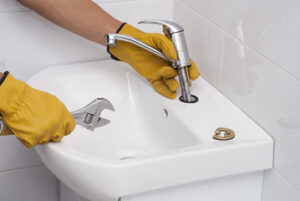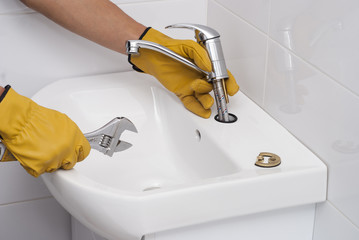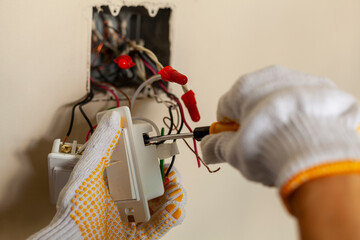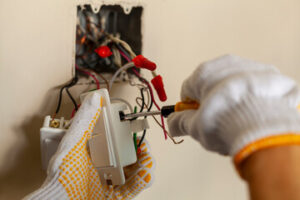Before attempting faucet repair, turn off the water supply to the fixture. You may lose small parts or cause a leak if the water is still running.
Start by removing the aerator (if there is one). Then, remove the handle(s) and decorative part of the escutcheon. Next, unscrew the disk cylinder mounting screws. For professional help, contact Plumbing Express, Inc. now.
Many homeowners are able to fix leaky faucets themselves with only basic tools. It’s important to learn about the different types of faucets (ball, cartridge, and ceramic disk) as each type may have its own unique set of problems. In addition, it’s important to understand what causes a leaky faucet so that you can troubleshoot the problem and identify the appropriate solution.
For example, a leaking faucet with a ball or cartridge head can usually be fixed by tightening the adjusting ring or packing nut, which holds the valve seat or stem in place. In some cases, this can be as simple as a few turns with a wrench, but it’s also possible that the nut needs to be removed completely and replaced.
Another common cause of a leaking faucet is worn out or damaged O-rings. These rubber seals are located under the spout and create a water-tight seal, but over time they can become worn out or cracked, which allows water to seep through. You can usually find replacement O-rings at a hardware store or plumbing supply specialist, but make sure the new O-ring is an exact fit for your faucet. Also, it’s a good idea to coat the new O-ring with plumber’s grease before installing it.
If you have a leaky faucet with a ceramic disc, the most likely culprit is worn out neoprene seals that are located in the base of the ceramic-disk cylinder. To replace these seals, you’ll need to remove the handle, unscrew the escutcheon cap, and loosen the disk cylinder mounting screw with a blunt screwdriver. Then, you can remove the cylinder and sand the bottom of the ceramic disk with emery cloth to restore its smoothness and remove any dirt that has collected inside the cylinder openings.
Once the cylinder is removed, you can install the new seals and reassemble the faucet. When reassembling, be careful not to overtighten screws or nuts as this could damage or bend delicate parts of the assembly. Finally, turn on the water to test your work and make any necessary adjustments. If you’re still experiencing a leaky faucet after following these instructions, it may be time to call a plumber in San Diego.
Repairing a Faucet with a Cartridge
Cartridge-style faucets often have mineral deposits that clog the valve seat. When this happens, water no longer passes through the cartridge, and the faucet begins to leak. You can usually fix this by replacing the cartridge. The best way to do this is to take the old cartridge with you when buying a replacement, so that you can make sure it’s an exact match. It’s also a good idea to pick up some plumber’s grease for the new O-rings, as well as the brass screw on the top of the cartridge shaft if it has one (some don’t).
Before you begin, shut off the water supply. Then, remove the handle by unscrewing the screw on the back side of the handle. If there’s a bonnet nut holding the cartridge in place, remove it with a crescent wrench. Some cartridges have two tabs that fit into notches on the faucet body to hold them in place; if yours is one of these, use pliers to pull it straight up. You may need to twist the cartridge a bit as you do this to get it fully seated.
Once the cartridge is out, clean off any mineral deposits with distilled white vinegar and a scouring pad. Use a utility knife to cut off any old O-rings and coat the new ones with nontoxic, heat-proof plumber’s grease. You’ll likely have to replace the rubber washer that sits at the bottom of the cartridge, too.
You’ll also need to replace the cam washer and the retaining clip, which is sometimes made of stainless steel and has a keyway on its cap. If your faucet has double handles, check to see which one is leaking. If both are, it’s important to reinstall the cartridge in the same direction, so that the tabs on the cartridge line up with the corresponding notches on the faucet body.
To do this, use a screwdriver to remove the decorative caps on the handle, which will expose the screw that holds the handle in place. Then, loosen the screw with a screwdriver and tilt the handle back to remove it. You’ll need to replace the decorative cap once you’re finished with your repairs.
Repairing a Faucet with a Ball
You’ll be able to find parts for cartridge-type faucets at most hardware and home centers, but the parts you’ll need to repair a ball or ceramic-disk faucet will be more difficult to find. You may have to order them, or you can try to make your own parts from washers and O-rings purchased separately. Before you begin working, shut off the water supply to the faucet. Then, loosen the set screw on each handle with a wrench or screwdriver and remove the handle. This will expose the screw that holds the valve seat in place. If the screw is tight, use pliers to loosen it. You’ll also want to remove the decorative cap at the top of the handle, which should have an “H” for hot and a “C” for cold. This will reveal a screwhead underneath, which you can remove with a screwdriver.
Once the screw is removed, you can lift out the valve seat and replace it if necessary. The rubber seats and springs are usually easy to remove from the valve seat as well. If you can’t get them out, you can cut them free with a knife and then reassemble the faucet by inserting the new seats and springs. It is important to install the new spring with the narrow end down. Otherwise, it will push the seal out of place.
Lastly, you’ll need to replace the cam and packing to restore water flow to your faucet. You can do this by first loosening the cam nut, which is a cone-shaped piece below the handle. This can be done with a wrench or pliers, but you’ll need to remember the orientation of the nut and packing when reassembly occurs.
You can now replace the plastic cam, which should come with a new packing and a new gasket. Once you do this, you can replace the nut and cam washer with a wrench or pliers. You’ll need to remember the orientation of the washer and cam, as you will be reassembling them in reverse. Now, you can reinstall the handle and turn on the water to test for leaks.
Repairing a Faucet with a Ceramic Disc
Ceramic disc faucets have a very sleek and luxurious look that is very popular. However, like all faucets they do need maintenance and repair. The main problem with these type of faucets is mineral build up that causes them to leak or not work properly. This is usually a problem in areas that have hard water. The good news is that it is very easy to fix. Generally you can just remove the cartridge and give it a good rinse. In some cases, especially if there is a lot of sediment, you can soak the cartridge in a mixture of 50% water and vinegar for 30 minutes and then rinse it again. Once it is cleaned it will usually be fixed and you can just put the cartridge back in and turn on your water again.
First, you need to shut off the water supply to the faucet. You will need to locate the hot and cold shutoff valves that are connected to your water pipes under your sink and turn them off. The valves will often have knurled knobs that you can rotate clockwise to shut them off. Once the water is off you can start working on your faucet.
Next, you need to remove the handle from the faucet. There is a screw that holds the lever to the lever post and you will need to remove this screw with a screwdriver. Once you have removed the handle, pry off the decorative cap that covers the cartridge and loosen the set screw that holds it in place. Once the set screw is removed you can pull the cartridge out and inspect it for damage. The rubber seals in the cylinder might need to be replaced. If they are worn or damaged, you can use a nonmetallic scrubber to clean the cylinder openings and then replace the seals.
Once the seals are replaced, you can put the cartridge back in and turn on your faucet again. If you have a single-handle faucet, you can now install the new cam washer and replace the decorative cap. Make sure that you align the keyway on the cam cap with the tab on the faucet body so that the cartridge will stay in place.


 As the name implies, residential electricians work on electrical systems in homes and other buildings.
As the name implies, residential electricians work on electrical systems in homes and other buildings.